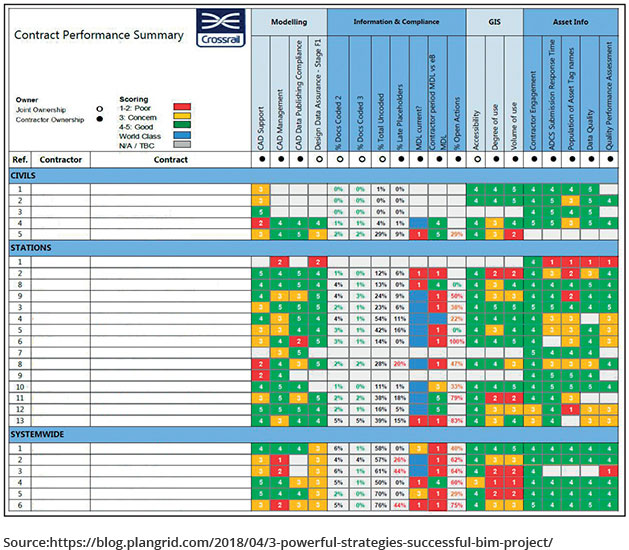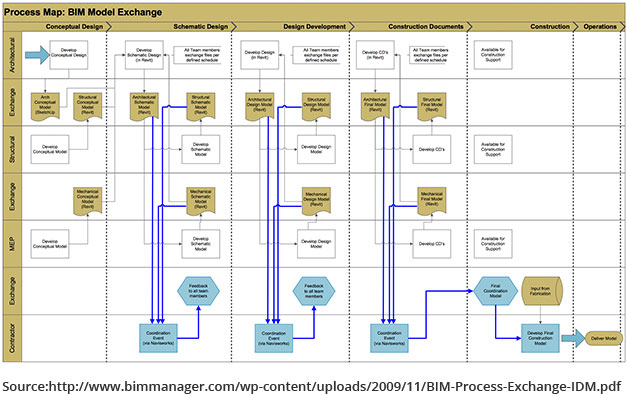BIM is metamorphosing the AEC Industry since the last decade. The industry is gradually adopting this digital technology to improve its productivity, enhance its sustainability, remain significant to its audience, and slowly evolve with time.
The BIM market is on the rise, a global forecast has projected the BIM market to reach by $7.6 billion in 2022 from $3.2 billion in 2016. According to the national BIM report 2018, BIM adoption has seen a growth of 17 percent compared to the previous year.
The construction industry is heading towards BIM, a study by McGraw-Hill Construction stated that nearly 71 percent of architects, engineers, contractors, and owners have started using BIM in their projects.
However, a major part of the AEC industry still finds it challenging and is hesitant to adopt this digital technology. BIM implementation requires a considerable amount of change in the organization and its process and to diffuse it across the business, a proper implementation framework and strategy are required.

Major challenges encountered by the businesses while exercising BIM
Lack of understanding/knowledge of BIM technology – The absence of a proper understating and enormous benefits of BIM is one the major hindrance in its adoption. Because of this lack of awareness, the demand for BIM among the clients or customers is reduced since they are not well versed in the principles of the technology.
Resistance to change – The tendency of the industry is another big road-block in BIM Implementation. A gap is created due to a lack of people’s acceptance of the technology and resistance towards change in the work process and organization.
Deficiency of BIM Trained staff – According to a study, 59 percent of the companies said they don’t have BIM trained staff. Also, many organizations perceive training as a time and resource-consuming task. To train the team on new technology and work processes is observed as a burden, after all, it requires an investment of resources.
Implementation Cost – BIM implementation costs not just include the cost of updating software technology but the cost of integrating entire business operation into a single system i.e., from compliance application to vendor specifications. The high cost of BIM implementation is another hindrance for businesses in BIM adoption. Especially, for businesses handling smaller projects, BIM implementation is not considered as a cost-effective approach.
The slow rate of ROI (Return of Investment) – Being a new approach, working on BIM will surely take some time to implement, bed in and build momentum. Adopting BIM is a long- term investment, it will require time to make the organization productive and beneficial.
The industry is facing both technical (Software and technical tools) as well as non-technical (organization behavior, strategies, process) issues in BIM adoption and its diffusion. And to handle these issues, the BIM implementation process needs to be covered at an operational and managerial level, including factors like Organizational behavior, information management, and training.
Who should Implement BIM?
An implementation framework should be created, starting from the Executive vision and sponsorship. This vision needs to be carried out by the leaders of the organization and by the project’s workforce.The vision should clearly be stated, what BIM business transformation it will bring to the organization, the primary elements involved in the transformation and various stages of it. The vision needs to be driven by the leaders, as they connect the vision to incremental change through the strategies, new policies, set standards, processes, and organizational change management. They need to monitor and motivate the change as well. These changes must be integrated throughout the business activities, as the implementers of the change are ones working on the shop floor.

How to Plan BIM Implementation?
BIM Implementation planning has to be categorized into several steps by including organization, people, process and technology and focusing on their challenges, activities, planning, communication, integration, and collaboration.
Step 1: Start with Pre-launch activities
Before launching BIM technology, pre-launch work should be done to smoothen the process of project completion activities. The pilot team needs to analyze the current activities like process, human resource, software, and other tools. The new process for BIM technology will be designed in the above analysis.
The software and hardware have to be examined to find out its support for the BIM technology and needs to be updated accordingly. The processing speed and data storage capacity needs to be validated as BIM uses a large amount of data and rendering and analysis of data requires a good processing speed. Cloud-based solutions are preferable for safety and easy accessibility of data, it also speeds up the design cycle and iterations.
Step-2: Forming a Pilot team
Form a pilot team for the project which can be employed in the real workplace. These are some of the technical parameters of pilot team members.
- 3D Design or BIM Exposure.
- Knowledge and understanding of traditional architectural design.
- Basic understanding of construction management process.
- Awareness of data and modeling techniques.
Since the pilot team is the first batch to be trained on BIM technology, the members must be technically sound to learn the software and put it into action. Test the coaching and mentoring ability of the team members before making them part of the pilot project, they will train and coach the rest of the members on this technology.
Step-3: Launching the Pilot Project
The next step after assembling the pilot team is to choose a pilot project. Before choosing a pilot project the willingness of the stakeholders i.e. Architect, Engineers, Contractors, and Owners is important for the success of BIM endeavors. They must be ready to take advantage of BIM technology and join the digital revolution.
One of the common mistakes made by most of the organizations is that they try to implement BIM across the whole organization at once. Initially, BIM should be rolled out on a low-risk project or on a small scale project.
In order to compare and predict the ROI, quality of product delivery and communication, the recently completed project can be picked as the pilot project for BIM.

Step-4: Documentation
Track each step of the pilot project, exercise documentation to note down the use of BIM Software at each step of the project. The documented data can be used for reference and to create the best practice for the rest of the team.
- The information to be documented are: Project information including Project manager, BIM Manager, and discipline leads.
- File exchange, quality control, meeting schedules.
- Quantity take-off list along with cost-estimation, operations, and processes.
- BIM site design and analysis.
Calculate the ROI, resource, and time saved by comparing this information with the comparison project (based on traditional methods). Develop a long-term BIM strategy, after analyzing these documents and feedback from team members and pilot project partners.
Step-5: Full Integration of BIM
The final step is integrating digital technology fully into the organization. The pilot project gives the best work practice, process, people and technology for the smooth implementation of BIM technology. The pilot team can mentor the rest team and support them when they get on-board with their knowledge, information, and experience.
Training on BIM tools, collaborative techniques, and skill up-gradation helps the employees to get comfortable with this shift in work culture and technology. New hires need immediate training on BIM to make them engaged with the organization and its work process and finally contribute to the organization’s productivity.
BIM Execution Strategy followed by Organizations
Success story of London Cross-rail Project
About the Project: London Cross-rail Project is a $21 billion public transport project and is Europe’s largest civil construction project. The aim is to build a high frequency, high capacity rails in London and the South East. The project deployed approximately 15,000 people in total.
Reasons to implement BIM: The project had to operate with nearly 0% margin of error in order to meet its KPIs. It required an efficient project planning and execution by the project stakeholders.
Challenges: To accomplish this BIM project, around 250,000 different models required to be clubbed together. And these models were linked to another database, included information about assets like light bulbs, fans, etc. and had a detailed description of all the work to be done.
Planning of BIM implementation: A precise BIM rule book, called BEP (BIM Execution Plan) was developed by the Cross-rail Project team to implement BIM in the project. BEP is a centralized planning document. The clear set goals, collaboration with project stakeholders, information transparency and scope for improvement provided by BEP keep all the stakeholders’ uniforms.

This image shows the benchmark assessment of the cross-rail project. Clearly defined KPI s with specific and joint owners helped to keep the project performance on the track. The project metrics were transparent, measurable, and evaluative.
Benefits: Clear and precise KPIs and assessed benchmark helped to track the performance of helped to monitor the progress and performance of the project.
BIM Implementation for full project Life cycle: Stanford University Neuroscience Health Center
About the Project: The Stanford University Neuroscience Health Center is a 92,000 square foot facility providing service to neuroscience patients. It is a project of $80 million and successfully implemented BIM in its entire project lifecycle.
Reasons to Implement BIM: To trace and monitor the project evolution from design, construction to facilities management stage.
Challenges: BIM Models has a huge amount of data and information, to identify the key information and keep it updated throughout a project lifecycle is a very crucial task. These key project information and data were supposed to be tracked and updated regularly throughout the lifecycle of the project for a better ROI.
BIM Implementation Plan: The BIM Implementation plan helps in developing BIM Model Exchange.

The model explains how the stakeholders of the project, i.e. contractors, architects, MEP engineers, structural engineers, etc. will interact with each other all throughout the whole project lifecycle. The model acts as a guideline on the progress of the model from conceptual to facilities management stage. The requirements of Model structure also helps in adding information to the BEP, the information to be included or excluded from the model can be decided based on these model structure requirements.
Benefits: The availability of vital information such as asset location, affected materials, ceiling height, etc. all through the project’s lifecycle reduced the time spent on onsite repairing by 60 to 70 percent. Smooth and efficient communication was also developed between the on-site staff and system engineers.
When to Think of BIM Implementation
BIM Implementation of business requires proper planning and the right strategy. It is similar to other change management process, as it changes the way everyone operates in the organization. So, a careful and well thought out strategy is required to implement it and make the process cost and time effective. The decision of BIM implementation has to be of the senior stakeholders and needs their support. The success of this initiative largely depends on the leadership team because of their financial support and capability to handle the business in disruption.

Consult an Experienced BIM Service Provider Before You Start
BIM Implementation requires expertise, so before going for the transformation, approach an experienced BIM service provider. eLogicTech is a BIM consultant with a team of experts who ensures a smooth and error-free transition from 2D to 3D BIM. With over 20 years of experience, our BIM experts will reduce errors at various stages and avoid any shift in production and superfluous cost of BIM implementation. Our team is well equipped with the latest software and hardware infrastructure. For more information, contact us today to talk to our BIM specialists directly and get a custom quote.







